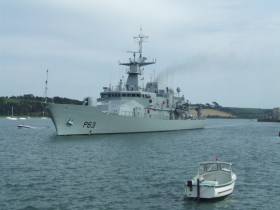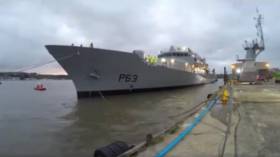Displaying items by tag: OPV LÉ William Butler Yeats
#NewestShip - The Appledore shipyard in the UK has completed its third Irish Naval Service patrol vessel as it prepares to start work on the next one.
According to the North Devon Gazette, the offshore patrol vessel (OPV) LE William Butler Yeats (P63) built at Babock Marine & Technology has been successfully handed over to the Irish Naval Service.
It had been on sea trials for several weeks and was spotted off the North Devon coast by many.
A spokesman for shipyard operators Babcock said: “LE William Butler Yeats has now successfully completed sea trials and has been handed over to the Irish Naval Service.
“Preparation work for our recent contract extension to build a fourth OPV is also well underway with production due to start in August.”
For more photos taken by Norman Hardaker of the third of this OPV90 'Beckett' class batch, click here.
#YeatsSeaTrials - Newest Naval Service OPV, L.É. William Butler Yeats (P63) began builder’s sea trials in the Bristol Channel until returning today to Appledore in the UK, writes Jehan Ashmore.
L.É. William Butler Yeats was floated-out in March from Babcock Marine & Technology’s yard at Bidna, Appledore in north Devon. The 1,900 displacement newbuild directly replaces the recently decommissioned L.É. Aisling (P23).
If the series of trails that began on Sunday, proceed according to plan, it is envisaged the OPV90 or 'Beckett' class newbuild will be delivered to the Naval Service base in Cork Harbour next month.
The newbuild represents the third OPV90 in which two such ships were originally ordered by the Irish Government. They are an improved version of the 'Róisín' class.
The successor class are the most sophisticated vessels of the Naval Service. They are equipped with Unmanned Aerial Vehicles (UAV) to carry out tasks in covert surveillence operations among them drug interdiction duties.
As previously reported on Afloat.ie, last month an order for a fourth of the class costing €54.3m (€66.8m after VAT) was contracted to Babcock International, again to the same UK shipyard.
Now that L.É. Aisling (P23) has been taken out of service from what was an eight-strong fleet, the current total is six vessels that is serving in domestic waters.
The seventh vessel L.É. Róisín (P51) since May has been deployed on a humanitarian role in rescuing migrants in the Mediterranean, though she is due to return to Ireland this month in mid-July.
In turn LÉ James Joyce (P62) is due to depart the Naval Base at Haulbowline this Friday. The second of the OPV90 Beckett class is to take over the Irish contribution to the humanitarian mission.































































